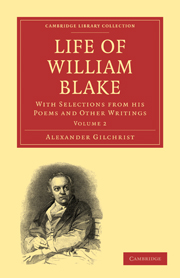Book contents
- Frontmatter
- Contents
- SELECTIONS: EDITED BY DANTE GABRIEL ROSSETTI
- POETICAL SKETCHES
- SONGS OF INNOCENCE
- SONGS OF EXPERIENCE
- THE BOOK OF THEL
- IDEAS OF GOOD AND EVIL
- PROSE WRITINGS
- NOTE UPON BLAKE'S ENGRAVED DESIGNS
- ANNOTATED CATALOGUE OF BLAKE'S PAINTINGS AND DRAWINGS
- DESCRIPTIVE NOTES OF THE DESIGNS TO YOUNG'S “NIGHT THOUGHTS,”
- ESSAY ON BLAKE
- IN MEMORIAM F. O. FINCH
- MEMOIR OF ALEXANDER GILCHRIST
- INDEX TO VOLUME I
- Plate section
IN MEMORIAM F. O. FINCH
Published online by Cambridge University Press: 05 July 2011
- Frontmatter
- Contents
- SELECTIONS: EDITED BY DANTE GABRIEL ROSSETTI
- POETICAL SKETCHES
- SONGS OF INNOCENCE
- SONGS OF EXPERIENCE
- THE BOOK OF THEL
- IDEAS OF GOOD AND EVIL
- PROSE WRITINGS
- NOTE UPON BLAKE'S ENGRAVED DESIGNS
- ANNOTATED CATALOGUE OF BLAKE'S PAINTINGS AND DRAWINGS
- DESCRIPTIVE NOTES OF THE DESIGNS TO YOUNG'S “NIGHT THOUGHTS,”
- ESSAY ON BLAKE
- IN MEMORIAM F. O. FINCH
- MEMOIR OF ALEXANDER GILCHRIST
- INDEX TO VOLUME I
- Plate section
Summary
[Mr. Finch, the reader will remember, was one of the young disciples much with Blake in his last days, from whom interesting reminiscences were gleaned.]
On the twenty-seventh of August, 1862, the old Society of Painters in Water-Colours lost, in Mr. Finch, one of their earliest members, who had long enjoyed, in the highest degree, their confidence and esteem, and the warm affection of such as had the pleasure of knowing him intimately. He was the last representative of the old school of landscapepainting in water-colours—a school which had given pleasure to the public for half a century, and contributed to obtain for Englishmen, in that department of art, an European reputation.
When he left school he was articled as a pupil to Mr. John Varley, from whose studio came also two of our most eminent living artists, one of whom has engraved, con amore, Varley's Burial of Saul; and from such a work we may estimate the value of his influence and instruction. It led to the study of refined models, and pointed to sentiment as the aim of art. It will, probably, be acknowledged that the aim was essentially right, and that, if the old school did not arrest and detain the eye by intricate imitation, yet that it was massive and manly, and that its tendency was to elevate and refine.
- Type
- Chapter
- Information
- Life of William BlakeWith Selections from his Poems and Other Writings, pp. 353 - 356Publisher: Cambridge University PressPrint publication year: 2010First published in: 1880

